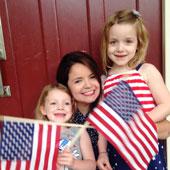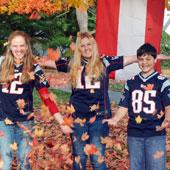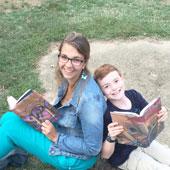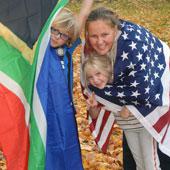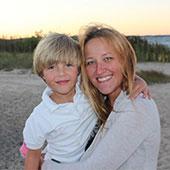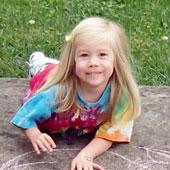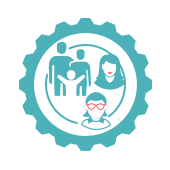Scoops with milk jugs: Cut the bottom off plastic milk jugs. Toss and catch lightweight balls or beanbags. As children get used to it, try throwing from a greater distance. This might be too hard for preschool age children; if so, they can try balancing a tennis ball on the neck and racing with it. How far can they go before it drops?
Here is an idea to use outside when it is clear, or indoors on a rainy spring day . Make an obstacle course – this idea can be adapted for any age group. Gather chairs, tables, boxes, stools, traffic cones, etc. and arrange them with the children to create places to climb on, crawl through, and go under and around. Try different variations; invite friends over to try it too.
CAR GAMES
Keeping children happy during long car rides or even during car pools around town can be challenging. One helpful approach is to engage them in car games – games that can be played by children ages 3 and up from the safety of their car seat or seat belt. These games come in handy any time a child is waiting and can’t be off exploring or playing. Always play along with them!
I see something
This is the easiest game for young children to play. Choose something that both you and the child(ren) can see and start by giving a clue by saying “I see something (say it’s color or shape)”. The children then take turns asking you questions about what you see. You can only answer “yes” or “no” questions. The person who guesses first can be the next to give the clue, or you can just take turns so that everyone gets to play if there is more than one child. Older children can play by thinking about things that everyone knows but that might not be in front of them, such as a favorite stuffed animal or a piece of furniture at home.
Twenty Questions
Similar to the above game, this game is for any school age children. One person thinks of something and identifies it to the other players simply as a person, place or thing. The players take turns asking questions which can be answered with a YES or NO. After 20 questions are asked, if the players have not already guessed the answer, each player gets a chance to make a guess. Then a new player tries to stump the others.
Alphabet Game
Children who are reading and can easily see out the window of the car can play this game. One child starts with A and has to find a word on a sign visible from the car with the letter A. The child has to identify where the letter was spotted. Players take turns until the alphabet is complete. You can decide if license plates can be used.
Initial Game
This game is best for middle school and high school age children. The first player thinks of someone who everyone who is playing would also know and tells the others the first letter of that person’s first and last names. It could be a personal friend, a politician, an author or even a television or movie character. The other players ask yes or no questions until they identify the person or give up.
Fishing at home (for children over 3)
Look around the house and spend some time with the child finding things that will stick to a magnet. Tie a piece of string to a stick. At the other end of the string tie a magnet. Put paper clips and other things that are magnetic in the “pond.” Or cut out paper fish and put a paper clip on each one.
Make a life-size paper doll (for children over 3)
Have the child lie down on a large piece of brown wrapping paper and draw an outline around the child. Let the child use crayons, markers or paint to put clothes and a face on the “doll.” It can also be a collage by cutting out fabric pieces for the clothes and yarn, string or even styrofoam pieces for the hair. In warm weather go outside and trace the child on the sidewalk with chalk and then color in clothes and hair.
Paper butterflies: Fold a piece of paper in half. Open the paper and drop small amounts of paint on half of the paper. Fold the paper in half again and rub your hand across the paper to spread the paint colors that are inside the folded paper together. With the paper still folded, cut out the shape of one side of a butterfly. Unfold the paper to see both sides of the butterfly. Allow the paint to dry, then draw the body and add antennae if you wish.
Children as young as three would love a Secret Hideout. This can be created out of a corner of the yard, under some branches, in a large appliance box, or by constructing a hiding place with blankets. Eat lunch in the hideout for a special treat. Imagine you are being discovered by pirates, or that your hideout is on a desert island. The same structure can be used in many different ways. School age children might enjoy building a hideout themselves (with your help). Cut a swinging door and windows into a large box from a refrigerator or a stove. Decorate with paint or markers. Furnish with small furniture or pillows. If there’s some extra fabric around you could even add curtains. Ask your host parents what blankets, pillows or other items could be used in the yard.

